A History of Perfection: TFB’s Definitive Guide to all Glock Generations
https://ift.tt/36MH0xb
The popular phrase “there’s always room for improvement” rings true no matter what industry you’re in. Even for venerated manufacturers such as Smith & Wesson, SIG Sauer, and Glock, there are always tiny steps here and there that are taken to improve their product. Today we’ll be taking a look at the various Glock generations and explore what improvements (or setbacks) were made to the popular line of polymer Austrian pistols over the years.
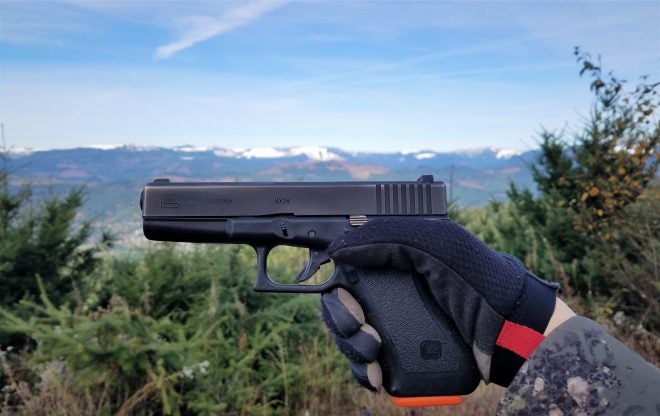
A History of Perfection: TFB’s Definitive Guide to all Glock Generations
Glock Generation 1 – 1982
By 1984 Glock was still operating out of just a single building in Deutsch Wagram, Austria. Gaston Glock and 3 employees were hard at work making consumer goods and by the late 70’s even some military hardware. Specifically, the FM 78 Field Knife and machine-gun belt links were at the forefront of their product catalog by the 80s.

A History of Perfection: TFB’s Definitive Guide to all Glock Generations – The Original Glock Headquarters
The Glock 17 was the first pistol to come to market after nearly 3 years of development within Glock headquarters. The result of this design process was the semi-automatic polymer-framed Safe Action Glock 17 9mm pistol. The pistol was very bare-bones at this point but proved to be functional and reliable and these qualities gave it much favor with various military and police departments across the globe.
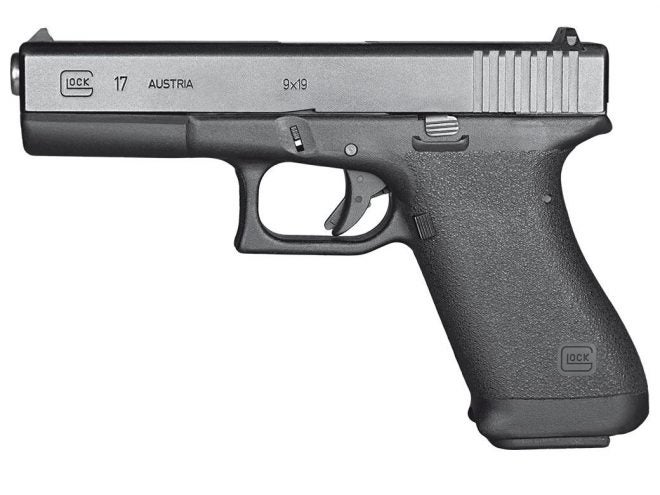
A History of Perfection: TFB’s Definitive Guide to all Glock Generations – Photo Credit: Glock
The design of the Glock 17 Gen 1 was simple. There was no accessory rail, the magazine release was minuscule and the grip texturing wrapped fully around the entire pistols grip. The grip pattern used on the Gen 1 pistol frames used a “pebble finish” and had no finger grooves.
Early Glock Gen1 pistols made use of a much thinner bore wall than later generations with the early barrels being referred to as “pencil barrels.” These pistols were produced between 1982 and 1986 and featured serial number prefixes “AF” through “AM”.
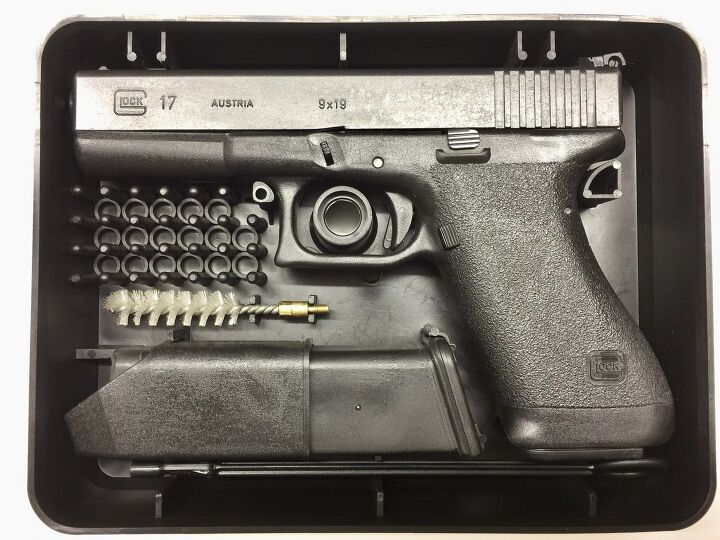
A History of Perfection: TFB’s Definitive Guide to all Glock Generations
The last notable feature about the Gen 1 Glock pistols was the pistol cases. Early Glock pistols were shipped in the iconic “Tupperware” boxes but Gen 1 Glocks produced and sold in Austria shipped with the case preformed for ammunition storage with these compartments later being removed for importation into the United States. The Generation 1 Glock pistols were produced until 1988 when the Gen 2 Glocks started to make their first appearance.
Glock Generation 2 – 1988
Up until 1988 Glock produced only the Glock 17 model. With the 2nd generation of pistols making their debut in 1988, Glock also released the new Glock 19 – a pistol that would go on to be arguably the most iconic product of the brand. In fact, Hop over on TFBTV argues that the Glock 19 Gen 2 is the greatest generation of Glock to have ever existed.
Gen 2 Glocks saw only minor improvements, some of which were only prompted by pressure from the ATF. For example, Glock had to include a steel serial number plate in order to comply with the BATFE’s regulations (Subpart C—FIREARMS TITLE 27). Other improvements were made to the magazine floorplate and magazine follower spring for improved performance. Glock Gen 2 also holds a special place in my heart as being the pistol heavily featured in the Half-Life series of first-person shooter games.

By 1991 Glock had also made revisions to the grip texturing by adding a checkering pattern to the front and rear instead of just on the sides as they had first been released in 1988. These grip modifications gave the user more purchase on the gun in all conditions. In addition to modifications to the grip design, Glock also introduced several calibers including .40 S&W, 10mm Auto, .380 ACP, and .45 ACP.

A History of Perfection: TFB’s Definitive Guide to all Glock Generations
In 1995 Glock also introduced the Glock 26 and Glock 27 – the first subcompact pistols made by Glock. These could be considered the first guns that targeted the consumer market rather than the police and military markets.
Glock Generation 3 – 1998
Glock Gen 3 pistols remain to this day some of the most popular handguns on the market. They have been in production for 20 years and are still being produced today and are available for sale. Gen 3 saw the addition of two new calibers (.45 GAP and .357 SIG) and a new feature – an accessory rail. The Universal Glock Rail allowed wielders of the pistols to mount lights and lasers to the gun for added utility.
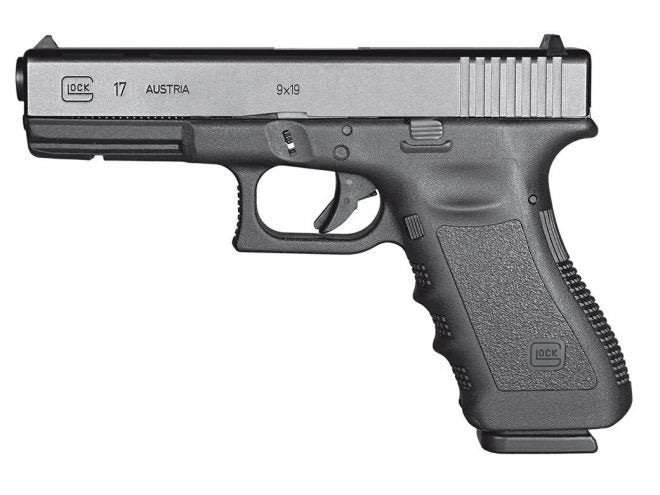
A History of Perfection: TFB’s Definitive Guide to all Glock Generations
Other improvements were the addition of a thumb shelf on both sides of the pistol to accommodate both left and right-handed shooters. By far the most contentious addition to the Gen 3 Glocks were the finger grooves. Many people, myself included, disliked the finger groves. For me, they gave the otherwise smooth lined pistol an odd feeling and awkwardly spaced out your fingers if they didn’t fit exactly inside the groves. However, not everyone disliked them and I supposed that is why the pistols are still being made to this day – someone is buying them.
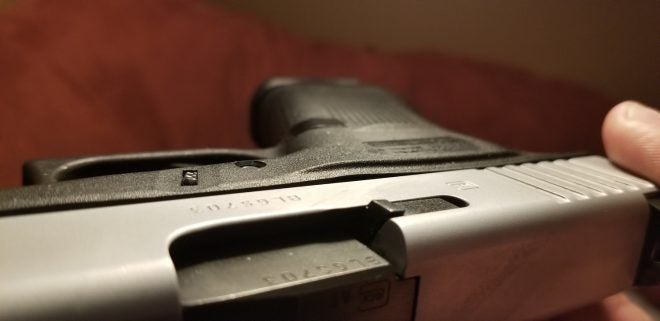
The raised extractor indicating the chamber has a round in it.
Gen 3 also added a life-extending cross pin to the rear of the trigger pin which reduced the stress encountered by the locking block when firing the pistol – this improvement leads to longer service life for the pistol. The last major functional improvement to the Gen 3 Glocks was the addition of an extractor which also served as a loaded chamber indicator. When the pistol had a round in the chamber, the extractor would stick up slightly from the frame giving you a visual indicator that the pistol was hot.
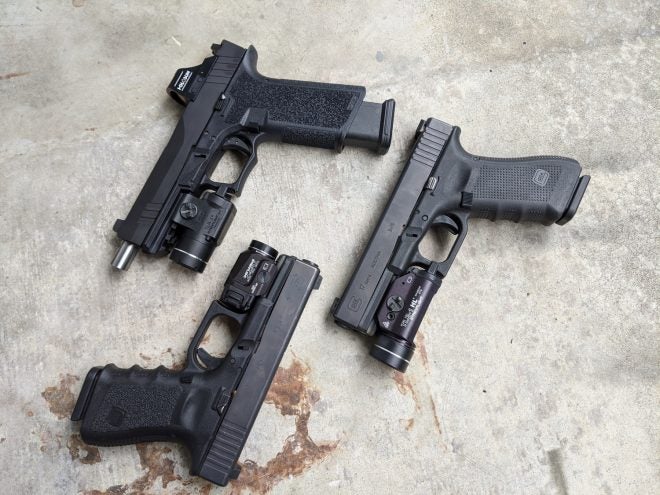
Before the start of Glock Gen 4 the Glock 22, 21, 31, 32, and 19 were all being offered in Glock’s new RTF2 (Rough Textured Finish) which had fish-scale style rear slide serrations and a new stippling pattern. These pistols were only offered for a limited time and are no longer being produced.
Glock Generation 4 – 2010
Gen 4 Glocks saw the first dimensional differences to the pistol which to date had been largely identical across generations. The addition of user-serviceable backstraps allowed the user to change both the beavertail and grip of the frame by swapping out Glock Modular Backstraps. The new frames’ base grips were also slightly smaller than previous generations
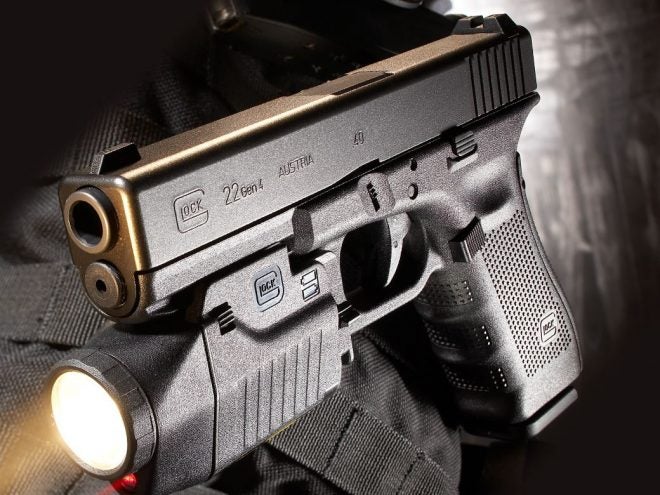
A History of Perfection: TFB’s Definitive Guide to all Glock Generations
A welcome improvement to Generation 4 was the larger magazine catch/release which was nearly tripled in size and was now reversible for both left and right-handed shooters. There was a minor drawback when it was first introduced as the current generation magazines had issues when the magazine catch was moved to the right side (for left-handed shooting). This problem was later corrected with the introduction of a new generation of magazines designed to circumvent this problem.
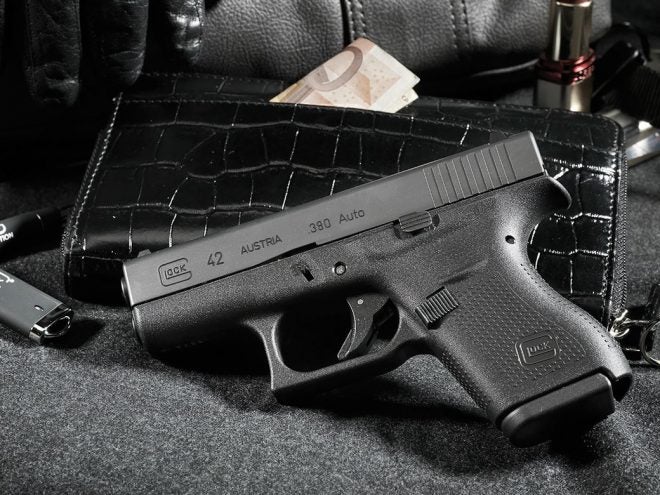
A History of Perfection: TFB’s Definitive Guide to all Glock Generations – A Glock Slimline G42 Pistol
The Generation 4 Glocks featured a new dual recoil spring which reduced the recoil felt when shooting and also had the benefit of reducing wear and tear on the gun. Alongside these improvements, two new single-stack “Slimline” pistols were introduced as part of generation 4 in 2014 and 2015. The Glock 42 .380 ACP pistol and the much favored Glock 43 9mm pistol were introduced as subcompact single stack pistols.
Glock Generation 5 – 2017
The newest numbered generation of Glocks made its debut at SHOT Show 2017 and to date has only released a handful of pistols. The current lineup includes only the 17, 19, 26, 34 MOS, 17 MOS, and 19 MOS pistols. The MOS pistols share a unique optics mounting plate for the addition of a micro red dot – something that spilled its way over into the United States Military Modular Handgun System competition.
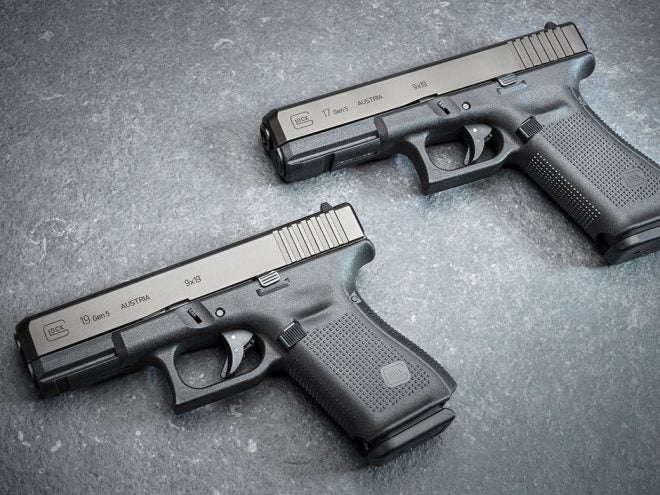
A History of Perfection: TFB’s Definitive Guide to all Glock Generations
Both the Glock 47 and 45 have since been added to the list of offerings with both being used by United States Customs and Border Patrol agents as their new duty weapon. However, more than just combinations of the already existing slide and frame sized were being added. Gen 5 also saw the addition of a flared magazine well, trigger guard relief cuts for a higher grip as well the first major changes to the internal components.
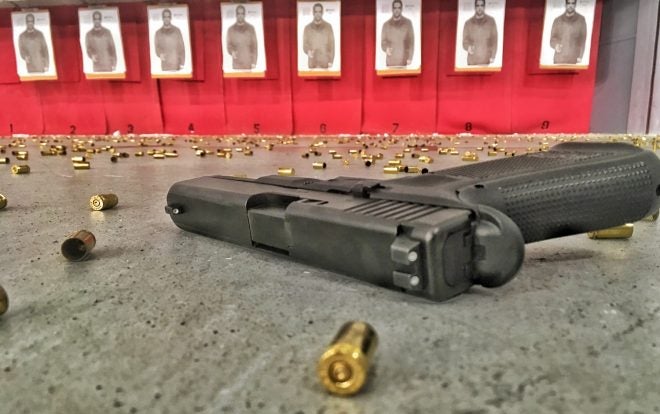
A History of Perfection: TFB’s Definitive Guide to all Glock Generations
The internal workings of Glock pistols had more or less remained unchanged since the Gen 1 Glock was introduced, however, the Gen 5 saw the removal of the cross pin that would normally be above the trigger guard. Glock also replaced the standard barrel with a Glock Marksman barrel for all Gen 5 Glocks and lastly, the outer coating is a newer nDLC coating. I’m not personally a fan of this newer coating as I much prefer the Tennifer ferritic nitrocarburizing that has been around and lasted throughout the decades on previous generations of Glocks.
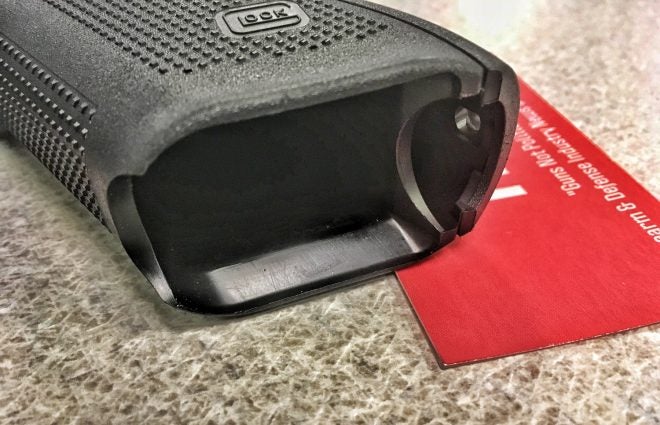
A History of Perfection: TFB’s Definitive Guide to all Glock Generations – The flared magazine well of a Glock Gen 5
Glock Sliver Slimline Era – 2019
The Slimline series of Glocks were released in early 2019 and made waves when they were revealed to the public. The Glock 48 and 43X were both single-stack 10 round capacity pistols using the Glock Slim 01 magazines. Not quite a Glock 19 but also not a Glock 43 and having features from the last three generations of Glocks makes these pistols almost a generation of their own.
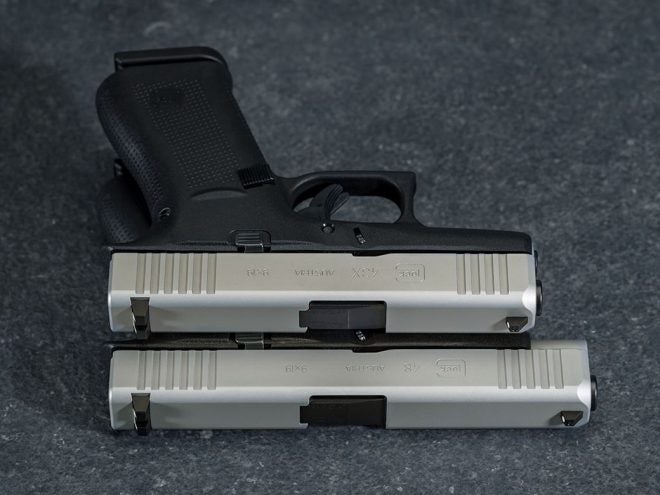
A History of Perfection: TFB’s Definitive Guide to all Glock Generations
One thing that sets the 43X and 48 (as well as the 43 and 42) is the unique firing pin and striker. All four of the pistols share the same striker and firing pin and these components are not compatible with any other generation of Glock pistol. Furthermore, the Slimline pistols nixed the finger groves from the Gen 3’s as well as the modular backstraps from Gen 4 and Gen 5 but at the same time add their own flair with an increase single-stack magazine capacity, a silver PVD finish and forward slide serrations.
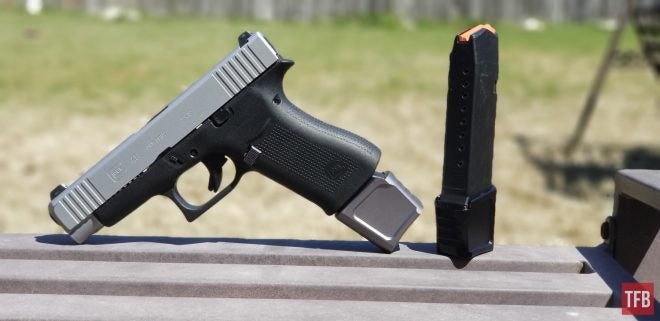
A History of Perfection: TFB’s Definitive Guide to all Glock Generations
Regardless of where these Silver Slimline pistols fit they are no longer being produced as they have been replaced by the more traditional all-black models which carry the same features but lack the non-reflective PVD coating. By far these Slimline Glocks have to be my favorite generation of pistols.
More to Come?
Glock continues to make improvements to their long line of pistols and is even branching out into new territory with the recently released Glock 44 22LR pistol. I would expect Generation 5 Glocks to continue for quite a while until we start seeing any signs of Gen 6 Glocks and by then who knows what we will see happen to the popular polymer pistol brand. What is your favorite generation and model of Glock and why? Let us know down in the comments!

Thanks to TFBTV’s Hop for some of the photos used in this article
We are committed to finding, researching, and recommending the best products. We earn commissions from purchases you make using the retail links in our product reviews.
Learn more about how this works
.
guns
via The Firearm Blog https://ift.tt/2JX8W99
May 27, 2020 at 08:01PM